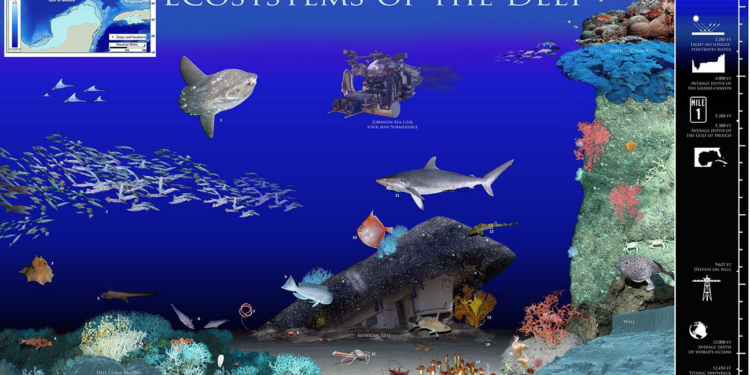Deep-sea ecosystem mapping has emerged as a pivotal area of research and innovation, particularly in the face of growing concerns about marine biodiversity preservation. Companies like Cosma are spearheading this movement, utilizing cutting-edge autonomous underwater vehicles to explore and survey our ocean’s depths. With a recent funding round aimed at industrializing their drone fleet, they are poised to revolutionize how we understand and protect these critical ecosystems. By combining ocean technology innovations with AI-driven analytical tools, Cosma is enabling large-scale benthic ecosystem monitoring to ensure sustainable marine practices. In a rapidly evolving landscape, the capacity to generate detailed digital models of the seafloor is paramount for informed decision-making and conservation efforts.
The exploration and assessment of marine environments, often referred to as underwater ecosystem surveys, are gaining traction as scientists and tech innovators prioritize the health of our oceans. Notably, Cosma, a pioneering entity founded to enhance the precision of oceanic assessments, is leveraging autonomous vehicles to conduct these vital surveys effectively. Their approach not only emphasizes the importance of marine biodiversity but also highlights how advancements like drone fleet industrialization can streamline data collection and analysis. Using high-resolution imaging techniques and cloud-based platforms, these efforts help in understanding complex benthic ecosystems while supporting broader goals of preservation and sustainable usage. This technological transformation marks a significant stride towards ensuring the integrity of underwater habitats amidst escalating anthropogenic pressures.
Innovations in Deep-Sea Ecosystem Mapping
The advancements in deep-sea ecosystem mapping have significantly evolved with the introduction of autonomous underwater vehicles (AUVs). Companies like Cosma leverage these technological innovations to create highly detailed maps of the ocean floor, which were once inaccessible. By employing advanced imaging techniques and AI-powered analytics, these vehicles can capture extensive data about marine environments, including intricate details about benthic ecosystems. This not only helps in pinpointing species distributions but also provides baseline data for monitoring environmental changes over time.
The unique ability of AUVs to operate in challenging underwater conditions enables the compilation of high-resolution, three-dimensional models of seabed habitats. With more than 75% of the ocean floor yet to be explored in detail, the role of technology like Cosma’s is crucial. These innovations not only enhance our understanding of marine biodiversity but also reinforce the importance of protecting these delicate ecosystems from human impact, paving the way for a new era in ocean conservation and research.
The Role of Autonomous Underwater Vehicles in Marine Biodiversity Preservation
Autonomous underwater vehicles play a pivotal role in preserving marine biodiversity by facilitating comprehensive monitoring of underwater ecosystems. Cosma’s use of AUVs allows for the collection of massive data sets, yielding up to 100,000 images per hectare of seabed. This wealth of information is critical in identifying various habitats and species that occupy the ocean floor, which can inform conservation efforts. With less than 1% of marine species currently documented, the potential for new discoveries is immense, marking the beginning of a more knowledgeable approach to marine conservation.
Moreover, the insights gained from benthic ecosystem monitoring through AUVs not only contribute to biodiversity initiatives but also assist industries, such as construction and energy, in mitigating their impacts on fragile marine environments. By employing such technology, stakeholders can make informed decisions that align with environmental regulations, thus ensuring that marine biodiversity is preserved while also allowing for sustainable industrial development. The integration of AUVs in marine research exemplifies a forward-thinking approach to tackling the complex challenges faced by our oceans.
Advancements in Ocean Technology Innovations and their Impact on Marine Research and Conservation Solutions
Ocean technology innovations are transforming marine research and conservation strategies. Companies like Cosma are harnessing cutting-edge technologies, including autonomous underwater vehicles, to enhance the collection and analysis of biological data. These innovations are significant as they not only improve efficiency but also grant researchers invaluable insights into underwater ecosystems, orchestrating a new horizon for marine conservation. AUVs equipped with technologies that capture high-resolution imagery enable scientists to monitor sensitive marine habitats and track changes over time.
As the need for preserving ocean biodiversity intensifies, the role of such advancements becomes even more critical. Investments in ocean technologies can lead to breakthroughs that ensure sustainable use of marine resources and protection of vulnerable species. Furthermore, integrating AI-driven data processing with autonomous exploration allows researchers to develop comprehensive strategies to navigate threats to marine ecosystems, ensuring that the ecological integrity of the oceans is maintained for future generations.
Drone Fleet Industrialization in Marine Research
The industrialization of drone fleets represents a revolutionary shift in marine research capabilities. With Cosma securing €2.5 million in funding, the company aims to refine its operations and expand its fleet of autonomous underwater vehicles. This scaling of drone fleets not only enhances data collection efforts but also allows for a broader range of applications, from scientific research to environmental monitoring and infrastructure assessment. The implications of deploying fleets of drones are profound, as they can cover extensive areas of the seabed in significantly less time compared to traditional methods.
As more organizations recognize the value of combining advanced marine technology with aerial drone fleets, the patterns of research and conservation approaches will also evolve. The industrialization of these fleets will facilitate easier access to previously unexplored areas of the ocean, ensuring that marine biodiversity is mapped and preserved efficiently. The future of marine science stands to benefit greatly from these innovations, spearheading efforts to maintain the balance of underwater ecosystems while advancing industrial interests.
Benthic Ecosystem Monitoring: A New Frontier for Ocean Conservation
Benthic ecosystem monitoring has emerged as a critical frontier in ocean conservation efforts, shaped greatly by the advent of technologies such as autonomous underwater vehicles. Companies like Cosma are pioneering techniques that provide comprehensive assessments of seafloor habitats, enabling better management practices for marine resources. These assessments help in identifying critical habitats, assessing ecological changes, and informing policies aimed at biodiversity conservation. Continuous monitoring not only protects existing resources but also raises awareness of the need for sustainable practices in marine industries.
With robust data on benthic communities, stakeholders can make better decisions regarding the impact of human activities on these fragile ecosystems. The deployment of AUVs for detailed monitoring creates a compelling narrative around marine biodiversity preservation, illustrating how technology can serve the interests of both the environment and industrial development. This holistic approach to monitoring ensures that marine borders are respected and valued, thereby fostering a deeper understanding of our oceans and the organisms that inhabit them.
The Importance of High-Resolution Seafloor Data for Marine Infrastructure Projects
High-resolution seafloor data is becoming increasingly critical for the planning and execution of marine infrastructure projects. With Cosma’s innovative approach of utilizing autonomous underwater vehicles for deep-sea mapping, stakeholders are empowered with accurate and reliable information that can directly inform construction and maintenance operations. Understanding the complexities of seabed environments helps to mitigate risks associated with offshore installations and ensures compliance with environmental standards.
This data-driven approach is crucial for preventing damage to sensitive marine habitats during construction activities. For instance, by keeping track of the locations of protected species and critical habitats, companies can adapt their strategies to minimize ecological impacts. The integration of high-resolution mapping into marine projects not only enhances operational efficiency but also supports broader conservation efforts, reinforcing the synergies between economic development and marine biodiversity preservation.
Public and Private Sector Collaboration in Marine Conservation Initiatives
Public and private sector collaboration is essential for advancing marine conservation initiatives, particularly as ocean challenges intensify due to environmental changes. Cosma’s partnerships with leading organizations, including the World Wildlife Fund and the French Navy, exemplify how diverse entities can come together to address common goals. By aligning resources and expertise, these collaborations enhance research capabilities and expand the impact of marine conservation efforts.
Such partnerships also facilitate the sharing of innovative technologies and methodologies, allowing for more effective strategies in monitoring and preserving marine biodiversity. Collaborative efforts may lead to funding opportunities for scientific research and conservation programs, ensuring sustained investment in ocean health. Ultimately, the success of these initiatives hinges on the collaborative spirit that brings various stakeholders into the fold, driving meaningful change within marine ecosystems.
The Future of Marine Biodiversity and Its Implications for Technology Adoption
The future of marine biodiversity will be heavily influenced by the adoption of innovative technologies in ocean exploration and monitoring. With the pressing need to address declining biodiversity, companies like Cosma are at the forefront of this transformative shift. By utilizing advanced tools such as autonomous underwater vehicles and AI-driven analyses, researchers can gain unprecedented insights into the health of marine ecosystems. As technology evolves, it will continually provide the means to map, study, and ultimately protect these vital habitats.
Moreover, as the pressure on marine resources intensifies, stakeholders across various sectors will increasingly rely on technological solutions to inform their practices. Understanding how human activity impacts biodiversity will become pivotal to sustainable development. Embracing these new technologies not only enhances operational efficiencies but also fosters a culture of responsibility towards marine conservation, driving collective action to safeguard the future of our oceans.
Securing Funding and Support for Marine Technology Initiatives
Securing funding and support for marine technology initiatives is imperative in driving forward innovation in ocean research and conservation. As demonstrated by Cosma’s recent €2.5 million funding round, strategic partnerships and collaborations play a crucial role in advancing these initiatives. Support from public organizations and investors can significantly amplify the impact of marine technologies, fostering advancements that are essential for understanding complex ecosystems and preserving biodiversity.
Furthermore, funding sources like France 2030 underscore the importance of governmental support in realizing marine conservation goals. As public awareness of the environmental crisis grows, there is an increasing demand for investments into technologies that can provide real-time solutions for monitoring and protecting marine environments. Tapping into diverse funding opportunities ensures that the tools necessary to safeguard our oceans continue to evolve and expand, ultimately benefitting all stakeholders involved.
Frequently Asked Questions
What are the key benefits of deep-sea ecosystem mapping using autonomous underwater vehicles?
Deep-sea ecosystem mapping using autonomous underwater vehicles (AUVs) provides numerous benefits, including high-resolution data collection, efficient surveying of vast marine areas, and the ability to monitor benthic ecosystems without disturbing marine life. This innovative technology enhances marine biodiversity preservation by generating detailed seabed models that allow scientists to analyze habitats and protected species effectively.
How does Cosma contribute to marine biodiversity preservation through deep-sea ecosystem mapping?
Cosma contributes to marine biodiversity preservation by utilizing advanced autonomous underwater vehicles to map deep-sea ecosystems comprehensively. Their technology enables the collection of extensive biological data, aiding in the identification and protection of sensitive species and habitats. By creating digital twins of the seabed, Cosma ensures informed decision-making for conservation efforts.
What role do ocean technology innovations play in deep-sea ecosystem mapping?
Ocean technology innovations, such as those implemented by Cosma, play a crucial role in deep-sea ecosystem mapping by providing cutting-edge tools and methodologies. These innovations include AI-driven data processing, 3D photogrammetry, and enhanced imaging techniques, which collectively improve the accuracy and efficiency of surveying deep-sea environments, facilitating better understanding and management of marine biodiversity.
How is the drone fleet industrialization impacting deep-sea ecosystem mapping?
The industrialization of drone fleets significantly impacts deep-sea ecosystem mapping by increasing operational capacity and enabling large-scale data collection over extensive marine areas. This development leads to faster and more reliable monitoring of benthic ecosystems, allowing for real-time assessments of marine biodiversity and enhancing the protection of vulnerable species and habitats.
What projects or collaborations is Cosma involved in for deep-sea ecosystem mapping?
Cosma is collaborating with various organizations, including RWE, the World Wildlife Fund (WWF), and the French Navy, to advance deep-sea ecosystem mapping projects. These partnerships leverage Cosma’s technology to support renewable energy initiatives, conservation efforts, and marine safety operations, demonstrating the practical applications of their mapping capabilities in diverse fields.
Why is high-resolution deep-sea mapping important for understanding marine ecosystems?
High-resolution deep-sea mapping is essential for understanding marine ecosystems as it provides precise data on seabed composition, habitat distribution, and species presence. This information is critical for informing conservation strategies, assessing the health of benthic communities, and ensuring the sustainable use of marine resources, thereby supporting overall marine biodiversity and ecosystem integrity.
How does Cosma’s technology help in avoiding sensitive species during offshore construction?
Cosma’s technology aids in avoiding sensitive species during offshore construction by providing detailed maps and models of the seabed. By identifying the locations of protected habitats and species through comprehensive mapping, stakeholders can make informed decisions that minimize environmental impacts and ensure compliance with conservation regulations while executing construction projects.
What future advancements can be expected from Cosma in the field of deep-sea ecosystem mapping?
Future advancements expected from Cosma in deep-sea ecosystem mapping include enhancements to their AI-driven analysis tools, further industrialization of their autonomous drone fleet, and expanded capabilities for processing larger datasets. These developments aim to provide even more detailed and actionable insights into marine ecosystems, ultimately supporting greater biodiversity preservation efforts globally.
| Key Points | Details |
|---|---|
| Company Overview | Cosma is a DeepTech company founded in 2022, focusing on mapping deep-sea ecosystems using autonomous vehicles. |
| Funding Amount | €2.5 million raised, led by WIND and Ternel, supported by various partners including Caisse d’Épargne Côte d’Azur and IFREMER. |
| Technology | Cosma deploys autonomous underwater robots capable of capturing up to 100,000 images per hectare of seabed. |
| Objective | The aim is to industrialize the inventory and monitoring of benthic ecosystems, aiding in ocean biodiversity preservation. |
| Data Collection Method | The use of a 3D photogrammetry system and AI algorithms to generate seabed models, recognizing habitats and species. |
| Significance | Only 25% of the ocean floor is mapped with high precision; Cosma’s efforts could help bridge this knowledge gap. |
| Clients | Early clients include RWE, EGIS, WWF, and the French Navy, indicating growing interest in Cosma’s services. |
Summary
Deep-sea ecosystem mapping is crucial for understanding and preserving marine biodiversity. Cosma, with its innovative technology and substantial funding, is poised to revolutionize how we explore and monitor underwater environments. By utilizing advanced autonomous underwater robots and AI-driven data processing, the company is setting the benchmark for high-resolution seabed mapping, addressing both ecological and infrastructure needs in oceanic studies.












